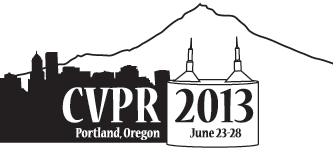-
Object Tracking by Occlusion Detection via Structured Sparse Learning
AbstractSparse representation based methods have recently drawn much attention in visual tracking due to good performance against illumination variation and occlusion. They assume the errors caused by image variations can be modeled as pixel-wise sparse. However, in many practical scenarios these errors are not truly pixel-wise sparse but rather sparsely distributed in a structured way. In fact, pixels in error constitute contiguous regions within the object's track. This is the case when significant occlusion occurs. To accommodate for non-sparse occlusion in a given frame, we assume that occlusion detected in previous frames can be propagated to the current one. This propagated information determines which pixels will contribute to the sparse representation of the current track. In other words, pixels that were detected as part of an occlusion in the previous frame will be removed from the target representation process. As such, this paper proposes a novel tracking algorithm that models and detects occlusion through structured sparse learning. We test our tracker on challenging benchmark sequences, such as sports videos, which involve heavy occlusion, drastic illumination changes, and large pose variations. Experimental results show that our tracker consistently outperforms the state-of-the-art.
Related Material
[pdf][bibtex]@InProceedings{Zhang_2013_CVPR_Workshops,
author = {Zhang, Tianzhu and Ghanem, Bernard and Xu, Changsheng and Ahuja, Narendra},
title = {Object Tracking by Occlusion Detection via Structured Sparse Learning},
booktitle = {Proceedings of the IEEE Conference on Computer Vision and Pattern Recognition (CVPR) Workshops},
month = {June},
year = {2013}
}
These CVPR 2013 workshop papers are the Open Access versions, provided by the Computer Vision Foundation.
Except for the watermark, they are identical to the accepted versions; the final published version of the proceedings is available on IEEE Xplore.
Except for the watermark, they are identical to the accepted versions; the final published version of the proceedings is available on IEEE Xplore.
This material is presented to ensure timely dissemination of scholarly and technical work.
Copyright and all rights therein are retained by authors or by other copyright holders.
All persons copying this information are expected to adhere to the terms and constraints invoked by each author's copyright.

